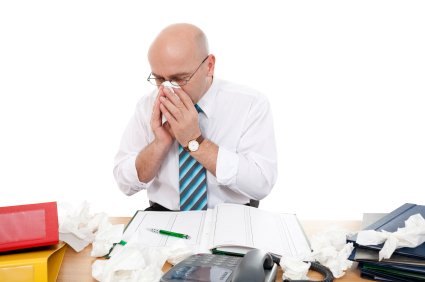 If you run a business or are an office manager, chances are that one of your main concerns has to do with keeping up productivity levels so that your company can compete in the local economy. As you probably know, one of the most important factors affecting productivity is absenteeism. According to the most recent Absence and Workplace Health survey, workplace absenteeism costs the British economy a whopping £14 billion a year. Most of it is due to sickness, as research has shown that the average British employee takes up to four more times the amount of sick days off than workers in other developed countries.
If you run a business or are an office manager, chances are that one of your main concerns has to do with keeping up productivity levels so that your company can compete in the local economy. As you probably know, one of the most important factors affecting productivity is absenteeism. According to the most recent Absence and Workplace Health survey, workplace absenteeism costs the British economy a whopping £14 billion a year. Most of it is due to sickness, as research has shown that the average British employee takes up to four more times the amount of sick days off than workers in other developed countries.
How to achieve a healthy office environment
Keeping your workforce healthy cannot be achieved by simply targeting one factor. It is important that office managers and business owners have a holistic perspective of what can be done in this respect, as the health of your workforce depends on both physical and psychological elements. So what are some of the things that can be done to improve the physical environment of your office in order to make it healthier?
Although it may seem obvious, cleanliness plays a crucial role in this respect. Office premises are occupied for at least 8 hours a day, 5 days a week, and in some cases, staff have to share a very limited physical space with each other. These conditions can prompt the rapid spread of viruses and other common winter ailments, such as the flu. In an office environment, it is particularly important to make sure that computer keyboards, telephone receivers, and surfaces in general are kept clean and disinfected. Also, bear in mind that dust and other irritants are easily trapped in carpets, and this may cause allergies or asthma attacks.
Temperature control is another important factor. The Health and Safety Executive does not specify a legal minimum, but it recommends that temperatures in office buildings are set at at least 16 degrees Celsius, and higher during the winter. However, excessive use of heating systems can be counter-productive, as temperatures that are too high can cause headaches and migraines. If you use air conditioning in your office to re-circulate the air, make sure that filters are kept clean and free of dust too.
Because daylight hours are shorter in the winter, it is important to fit adequate lighting in office premises. Poor lighting has been proven to cause stress, so whenever possible, try to ensure that staff have control over the lighting in their work areas. It is also recommended to check lighting in all areas of the office to avoid sudden changes in brighness.
Last but not least, consider offering a healthy option at the office’s vending machines, such as fruit, nuts, or cereals.
The secret of a healthy workforce
Ensuring that the physical environment is conducive to good health is important, but one cannot underestimate the importance of psychological factors. Human resources professionals have found that elements like excessive bureaucracy, poor opportunities for professional development, long working hours, and having inadequate resources to carry out their job are some of the factors that contribute the most to poor health among employees.
There are several things that can be done to improve the overall health and well being of staff. Some of the most important things involve reviewing the standard work practices regularly and requesting feedback from employees (either at staff meetings or in more informal ways). It is important to pay attention to things like unrealistic deadlines and communication styes between all members of staff. Whenever possible, managers should review job descriptions to see if or how they can be simplified. Offering frequent opportunities for training can also help in this respect, as this can help staff feel motivated and interested in developing their potential.
Much has been discussed about achieving an adequate work-life balance. Excessive travel time and inflexible work schedules can impact negatively on the health of your staff, so consider allowing flexi-time or tele-working, especially during the winter months, when harsh weather can increase the amount of time needed to get to the office. Also, think about implementing family-friendly policies if your staff have young children.
Admittedly, keeping your office environment as healthy as possible is not an easy task. Although office managers and business owners have a big responsibility in this respect, ultimately, maintaining a healthy working environment is everyone’s responsibility.
